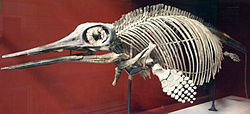| Ophthalmosaurines Temporal range: Middle Jurassic-Early Cretaceous,
| |
|---|---|

| |
| Composite skeleton (NHMUK PV R3702, R3893, R4124) of Ophthalmosaurus icenicus at the Natural History Museum, London | |
| Scientific classification | |
| Domain: | Eukaryota |
| Kingdom: | Animalia |
| Phylum: | Chordata |
| Class: | Reptilia |
| Order: | †Ichthyosauria |
| Family: | †Ophthalmosauridae |
| Subfamily: | †Ophthalmosaurinae Baur, 1887 |
| Genera | |
Ophthalmosaurinae is an extinct subfamily of ophthalmosaurid thunnosaur ichthyosaurs from the Middle Jurassic to the late Early Cretaceous (Bajocian - Albian) of Europe, North America and South America. Currently, the oldest and the basalmost, known ophthalmosaurine is Mollesaurus from the early Bajocian of Argentina. Ophthalmosaurines were characterized by a large extracondylar area of the basioccipital in the form of a thick and concave peripheral band, posterodistally deflected ulnar facet of the humerus, large ulna with concave and edgy posterior surface and ischiopubis with obturator foramen.[1]
- ^ Valentin Fischer; Michael W. Maisch; Darren Naish; Ralf Kosma; Jeff Liston; Ulrich Joger; Fritz J. Krüger; Judith Pardo Pérez; Jessica Tainsh; Robert M. Appleby (2012). "New Ophthalmosaurid Ichthyosaurs from the European Lower Cretaceous Demonstrate Extensive Ichthyosaur Survival across the Jurassic–Cretaceous Boundary". PLOS ONE. 7 (1): e29234. Bibcode:2012PLoSO...729234F. doi:10.1371/journal.pone.0029234. PMC 3250416. PMID 22235274.